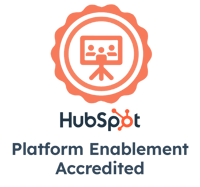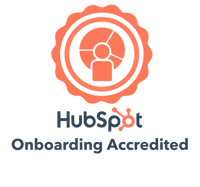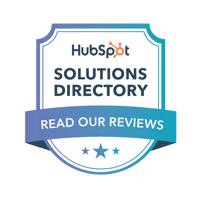Confession: I dread checking my messages on LinkedIn. I don't think I'm alone in that - and a big reason why is because I've been pitch slapped a few too many times to trust a random message anymore.
Yes, pitch slapped. I've been the victim many times, and I'm guessing you have too, even if you didn't have a name for it.
What is Pitch Slapping?
Pitch slapping is when you think you're having a normal conversation with someone and then BAM - you get hit with a sales pitch out of nowhere.
.webp?width=480&height=270&name=giphy%20(1).webp)
The most common type of pitch slapping is on LinkedIn. You get an invitation to connect, and the introductory message references a shared contact, common industry or other genuine basis for connection. Once you accept, they hit you up with a sales pitch - and most often, it's not even relevant to you.
With the rise of AI tools, pitch slappers use AI-generated content to seem like they're tailoring their message to you, but they're actually not. This makes it feel even more hollow - and frustrating.
Why it Sucks
Pitch slapping is sleazy, tacky and annoying. It's a "spray and pray" approach that just doesn't work with how buyers make decisions anymore.
If you've ever inadvertently pitch-slapped someone, it's not too late to change your ways. There are better methods for attracting leads and landing sales.
What to Do Instead
Pitch slapping is based on trickery and a bait-and-switch. A better strategy is simply this: be honest and provide value. The reason why some salespeople opt for pitch slapping instead is that it's easier for them - you can reach a ton of people quickly, with minimal effort (I also call it "lazy linking."
Developing a strategy and slowly nurturing leads takes time, but the results are better because you're empathizing with the buyer in their purchasing decision, not just slapping them with an irrelevant sales offer.
And it's not just me saying that, the data backs it up...
When B2B buyers are considering a purchase, the majority of that time is spent researching independently online. (Gartner)
63% of consumers who ask for information about your business or products won't make a purchase for at least 3 months. (Marketing Donut)
70% of buyers fully define their needs on their own before engaging with a sales representative, and 44% identify specific solutions before reaching out to a seller. (The Marketing Blender)
The leading reason why customers have limited engagement with B2B companies is that marketers are sending them too much irrelevant content. (Walker Sands)
Companies that excel at lead nurturing generate 50% more sales-ready leads at 33% lower cost. (Marketo Engage)
In B2B Sales, buyers research their problem, potential solutions and partners before they ever engage with a salesperson. With this in mind, let's focus on what to do to engage your potential buyer during this journey.
1. Identify Your Niche
One of the (many) reasons pitch slapping is so annoying is that the pitch is often irrelevant to the person on the receiving end. It's spam. Casting a wide net is not enough anymore - you're much better off identifying the needs of your actual buyer(s) as a starting point.
The best way to identify your niche is with strong buyer personas - semi-fictional representations of your ideal customers. A fleshed-out persona feels like describing a real person - with a name, age, job title, values, pain points and search intent terms. The strongest buyer personas are based on market research and insights you gather from your actual customers.
From there, you can map the unique buyer journey they take when making a purchasing decision.
Related Content: Walking the Buyer's Journey
2. Provide Value and Forge Genuine Connections
The trick for getting someone to engage with your brand isn't a trick at all: provide value. Once you know what they need, how they research for your solution and what will capture their attention, you can create compelling content that meets them during their journey. For example - if your buyer is comparing tools, you can create a comparison guide, and distribute it through your marketing channels.
Creating valuable content is definitely an investment - but it's more effective at reaching your target, and you can re-use it over and over again. A comparison guide can be repurposed into blogs, social media posts and emails.
Helpful content should be at the forefront of your sales strategy - not lazy pitches. Users online are more and more cautious about unsolicited cold outreach - especially when it includes data about them. It's creepy. Instead, focus on getting users to willingly initiate a conversation with you - for example, by filling out a form to download a content asset. From there, you have more of a basis for reaching out to them on LinkedIn. Instead of pitch slapping, you could invite them to discuss learnings from a relevant piece of content, and answer their questions.
Related Content: How to Get User Data: Cookieless Targeting in Online Ads
3. Use Technology to Automate, Not Replace
Technology like AI can be used effectively. One of the annoying things about pitch slapping is when salespeople send obviously AI-generated messages. It's an insult on top of injury—not only are you pestering me with an irrelevant offer, but you can't even bother to use your own words.
Instead, use technology to effectively automate helpful outreach once you've gained a contact's information. For example - maybe they download a content asset (whitepaper, quiz, etc.) or sign up for a webinar. You can use automation and AI to craft follow-up communications via email or SMS that invite them to take a specific action. Choose-your-own-adventure engagement lets them follow their needs.
Related Content: 5 Examples of Inbound Marketing Automation
4. Tap Into the Full Power of Inbound Marketing
Everything I've described so far is part of the inbound marketing methodology. It's an approach to marketing that recognizes the evolved nature of buyer behavior and as a result, focuses on walking alongside buyers instead of attempting to trick them. As a result, inbound marketing is incredibly effective at attracting high-value leads and converting them into customers.
Free Download: Everything You Ever Wanted to Know About Inbound Campaigns
Pitch slapping is the worst. Do better with smarter marketing. Inbound campaigns help you find, target, and convert your ideal audience. Click "get my eBook" below to learn how to create buzz-worthy Inbound campaigns that drive action.
BizzyWeb is a Minneapolis-based digital marketing and web design agency that helps companies get the high-quality leads they need to grow and thrive. Our tactics include inbound marketing, SEO, advertising, web design, content creation and sales automation. We are an accredited HubSpot Diamond Partner and we offer full-service HubSpot onboarding, enablement and strategy for new and current users.






